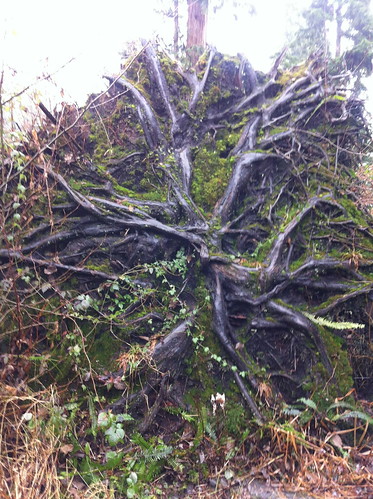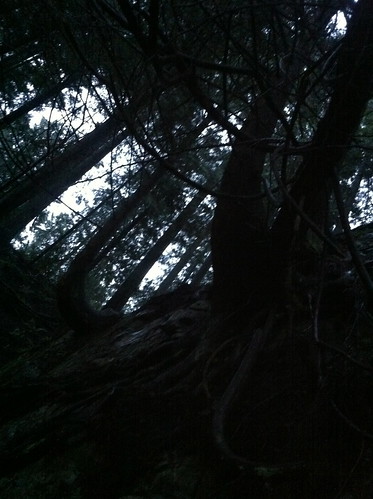Nerve's Root
"A longing to wander tears my heart when I hear trees rustling in the wind at evening. If one listens to them silently for a long time, this longing reveals its kernel, its meaning. It is not so much a matter of escaping from one’s suffering, though it may seem to be so" (Herman Hesse, Bäume: Betrachtungen und Gedichte [Trees: Reflections and Poems] ).
On living vertically: the tree stands still. It only knows upward motion to the light; or drilling to the depths of the dark soil with its roots. Even when the roots need to bypass a resistant rock or crack through a boulder, they are still vertically-oriented. Even when the branches are twining around an obstacle (another life-form, a building or a cliff) they are still climbing towards the sun.
The tree suffers silently. The tree does not even dream of escape or refuge from discomfort or disaster. Fires, logging and frost will attack it to its death, which it will welcome with barely as much as a sigh. It only knows of wandering and travel from the little birds that perch on its branches and whisper their sweet songs of freedom into its foliage.
When its arms are severed and when it is uprooted, a tree does not complain. It continues growing, silently, creaking only when the wind attempts to bend it beyond its range of flexibility. I long for the trees. When the snow and ice piles heavy on its boughs, the tree will carry these heavy waters as a water-bearer with a big family waiting in the village.
Despite all of these limits, the tree knows love. To the birds nesting on its boughs, feeding their youngsters. To the beetles that eat through its bark and tickle its thick skin. To the wind that caresses its tender foliage in springtime. To the children that climb its branches, jump on them and scrape their knees on them. To the earth that hugs its roots, and to the underground parasites pinching at its nerve endings. And even to the savage winds that uproot it; the loggers who take away its pride. It will still continue to grow and move forward, sending shoots of new life around the mother-trunk.
I am grateful and perhaps also cruel. In my apothecary I hold many lifetimes of trees and forests combined: essences from the fruits of junipers; needles of fir, spruce, cypress and pine; flowers of linden and balsam poplar; heartwood of santal, cedar, agar and oak; and tears (or sap) from frankincense, myrrh and hundreds of years old olive trees.
From my horizontal point of view, I might envy the tree now. I long for its dangerous exposure to the four elements. Admire its brave silence in face of all adversity. a sudden spring wind had sent me her blessing and promise of hope with a sprinkle of ume (Japanese sour plum) petals on my exercise mat that's been permanently placed by the windows now. The Hanami season is fading, and the scent of balsam poplar buds fills the air with its cotton-like warmth, reminiscent of honey, apricots, yeast and cloves.
On living vertically: the tree stands still. It only knows upward motion to the light; or drilling to the depths of the dark soil with its roots. Even when the roots need to bypass a resistant rock or crack through a boulder, they are still vertically-oriented. Even when the branches are twining around an obstacle (another life-form, a building or a cliff) they are still climbing towards the sun.
The tree suffers silently. The tree does not even dream of escape or refuge from discomfort or disaster. Fires, logging and frost will attack it to its death, which it will welcome with barely as much as a sigh. It only knows of wandering and travel from the little birds that perch on its branches and whisper their sweet songs of freedom into its foliage.
When its arms are severed and when it is uprooted, a tree does not complain. It continues growing, silently, creaking only when the wind attempts to bend it beyond its range of flexibility. I long for the trees. When the snow and ice piles heavy on its boughs, the tree will carry these heavy waters as a water-bearer with a big family waiting in the village.
Despite all of these limits, the tree knows love. To the birds nesting on its boughs, feeding their youngsters. To the beetles that eat through its bark and tickle its thick skin. To the wind that caresses its tender foliage in springtime. To the children that climb its branches, jump on them and scrape their knees on them. To the earth that hugs its roots, and to the underground parasites pinching at its nerve endings. And even to the savage winds that uproot it; the loggers who take away its pride. It will still continue to grow and move forward, sending shoots of new life around the mother-trunk.
I am grateful and perhaps also cruel. In my apothecary I hold many lifetimes of trees and forests combined: essences from the fruits of junipers; needles of fir, spruce, cypress and pine; flowers of linden and balsam poplar; heartwood of santal, cedar, agar and oak; and tears (or sap) from frankincense, myrrh and hundreds of years old olive trees.
From my horizontal point of view, I might envy the tree now. I long for its dangerous exposure to the four elements. Admire its brave silence in face of all adversity. a sudden spring wind had sent me her blessing and promise of hope with a sprinkle of ume (Japanese sour plum) petals on my exercise mat that's been permanently placed by the windows now. The Hanami season is fading, and the scent of balsam poplar buds fills the air with its cotton-like warmth, reminiscent of honey, apricots, yeast and cloves.



